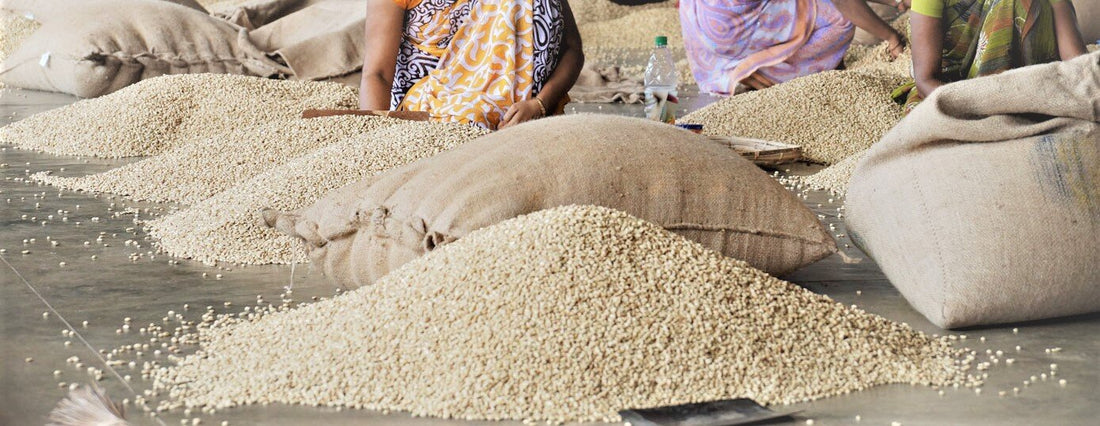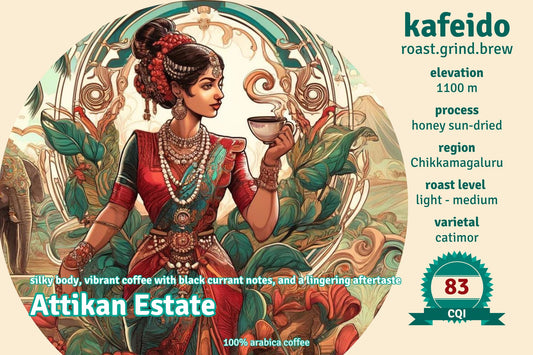
monsoon malabar, a fascinating bean
Share
monsoon malabar... buy here
monsoon malabar is the most intriguing coffee bean out there, period. the fact that it is an invention to duplicate the journey of wooden ships to ports in europe is enough.
today, i want to share from a roasters’ perspective why this bean is more than just a piece of history. i think it’s the legend really starts when it shows’ up on my table!
let’s start!
quality of the beans
until you have an army of staff checking for defects or buying the defect-free bag at a price ( hefty price!), you will be shocked at the number of defects in each batch. you can buy a better quality from tata estate or olam, but we can get their stuff only through australia or japan after paying reverse 135% customs duty.
in our opinion, monsoon malabar bags have a minimum 8% defect rate at best. that means, for every 170 grams you will find up to 13 grams of defective beans. that’s a lot.
then you have to think how much has this bean been gone through,
-
… ripening in the shade is an invitation to birds, insects, and civets
-
… picking and processing is another journey in itself
-
… then stay in an open window warehouse for months, constantly shuffled and racked
-
… going through sieves and dropped into bags, the beans are pretty brittle by now
here is how a monsoon malabar defect looks like,

this is a high def pic, you are free to hunt the defects in the green side… yep, we miss some.
this is a 180 grams batch for our individual customers. in the green circle, we have our good beans. orange circle contains beans that are fine by many but are defects for us, that’s because they mess up our roasts. the beans in the red circle are unacceptable for a roaster. we remove both orange and red from our roasts.
this is a batch for our larger orders. in one of them, we have pointed out the bean defects that unacceptable for a roaster. the other two pictures with circles, point out common monsoon malabar defects in our opinion. in the comparison we have not displayed all the good beans, the defect rate in the batch was 8%. we only roast the beans in the green circles.
let’s talk about four common monsoon malabar defects (mmds). again, in our opinion. you may or ay not find any vocabulary on them. now depending on who you are buying from, you may or may not get the normal green beans defects. although, you may get the aforementioned mmds from almost all the suppliers who are selling monsoon malabar in bulk.
over-monsooned
these spend more time in the store than a usual monsoon bean would. they impact the flavor, aroma, and acidity of our roast. if you are getting a flat taste from your monsoon malabar, you need to keep in mind that monsooned beans are time-sensitive. roast as soon as you get, longer you wait more you lose.
under-monsooned
they are still green compared to the batch, the moisture content and volume will impact the first crack time. the overall roast will be uneven. they stretch your first crack duration.
sour-faded monsooned
they usually occur when there is uneven monsooning or wetting after the processing. sometimes, the moisture content increases drastically after monsooning. similar to wet or undried beans in a normal defect. as they are monsooned they are harder to spot. they lead to loss of flavor and acidity.
sour-faded brittle
unlike the above, these are due to under monsooning and loss of moisture. they impact the first crack, but more importantly acidity and aromas.
within the general defects that you can get in any other bean, you will notice that parchment and broken beans are excessive compared to normal green beans. that is due to the fact monsoon malabar are not green beans. moreover, they are fragile from the gain in volume and constant raking in the warehouse.
please note that, we also remove all peaberry. we also remove beans with sizes different from the batch; large and small both. you can see them in the smaller batch picture.
roasting
congratulations! now you are ready to roast. if you are a newbie to monsoon malabar, then you will make the same mistake everyone does. you will measure the weight for the charge, not the volume. monsoon malabar has a higher volume than green beans, which means they will occupy more space for an equal weight of green beans. i
if you are not careful your roast will start off-target, and we all know…. what goes in is what comes out.
so the first thing is to understand that charge has to adjust for extra volume.
once you have charged, it is a rather uneventful journey till you reach the end of the roast. once the beans are out, you will notice that overall volume gain is less than green beans. also, monsoon malabar does not chaff as other beans do.
packaging
naturally, because of the higher volume, you might want to buy a different sized bag for monsoon malabar. you can use the same bag and print different weights, we do that for the purpose of uniformity. there are no specific studies, done for monsoon malabar, on dimethyl disulfide/methanethiol formation over weeks, so at this moment we can say they behave similarly to other roasted beans.
brewing
brewing itself is not special for monsoon malabar. it’s the grinds. you will notice that on medium grinds more than any other size.
the difference is more pronounced when you pour the water on them. they will bloom, they are really porous and prone to forming clots under the surface. this makes wetting the grinds tricky, you will have shorter bloom but uneven extraction. we suggest using a spoon to gently handle the grinds at bloom to even the floor. we suggest ordering a high-city, city, or full-city roast profile for pour-over.
when you are using a french press, be careful. the grinds need to be a degree less coarse than normal green beans. also, you will notice after the 3-minute mark you will have excessive residue on the top. we suggest ordering a full-city or french roast profile for french press.
espresso makers, monsoon malabar has low acidity and great body. you can work a normale at 6 bar with 23 sec at 1:2.5 ratio. if you are going for a lungo, please increase the pressure to 9 bar. we suggest ordering a full-city or french roast profile for espresso.
Notes
- please ask for the varietals in your monsoon malabar. monsooning is a process, malabar is a region. monsoon malabar is not a varietal, but processing from a region. you will find s.795 most of the time, in tata estate you will get the sln.9.
- do not expect the monsoon malabar from each region or estate to be the same quality or price. sellers know their quality better, buyers know their product better.
- if you really want acidity from these beans you can charge at 140 c and drop at beginning of the first crack, we think that’s like using diamonds for paperweights.
- note the timing of your beans’ harvest, and thestart of monsooning.
- if you want to blend them, please be careful about the volume and weight issue.







